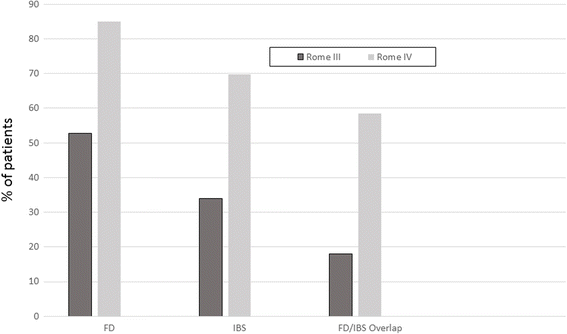Classification of pediatric functional gastrointestinal disorders related to abdominal pain using Rome III vs. Rome IV criterions
- PMID: 29549882
- PMCID: PMC5857312
- DOI: 10.1186/s12876-018-0769-z
Classification of pediatric functional gastrointestinal disorders related to abdominal pain using Rome III vs. Rome IV criterions
Abstract
Background: The primary purpose of this study was to compare Rome III and IV evaluation criteria for irritable bowel syndrome (IBS), functional dyspepsia (FD), and an overlap syndrome consisting of both IBS and FD by assessing the frequency of each diagnosis in a population of children with chronic abdominal pain. Frequencies of Rome IV FD subtypes of postprandial distress syndrome (PDS) and epigastric pain syndrome (EPS) were determined and FD/IBS overlap symptom associations were also assessed.
Methods: We conducted a cross-sectional retrospective chart review of 106 pediatric patients who had completed standardized medical histories as part of their evaluation for chronic abdominal pain. The patients ranged from eight to 17 years of age and reported having abdominal pain at least weekly for 8 weeks. Patients whose evaluation revealed gastrointestinal disease were excluded. The patients' diagnoses were determined by a single pediatric gastroenterologist utilizing the specific criteria for Rome III and IV, respectively.
Results: Patients were significantly more likely to be diagnosed with FD (84.9% vs. 52.8%), IBS (69.8% vs. 34%), and FD/IBS overlap (58.5% vs. 17.9%) by Rome IV criteria, as compared to Rome III criteria. With regard to Rome IV FD subtypes, 81.1% fulfilled criteria for PDS, 11.1% fulfilled criteria for EPS, 6.7% fulfilled criteria for both, and 1.1% did not fulfill criteria for either. Finally, we found an increased frequency of diarrhea and pain with eating in the overlap group compared to the non-overlap group of Rome III, while only an increased frequency of diarrhea was found in the overlap group compared to the non-overlap group of Rome IV.
Conclusions: Our data demonstrate that utilizing Rome IV criteria, as compared to Rome III, results in an increase in the diagnosis of FD, a two-fold increase in the diagnosis of IBS, and a three-fold increase in the diagnosis of FD/IBS overlap. Rome IV criteria appears to result in greater heterogeneity within diagnostic categories. It is important to determine whether Rome IV diagnoses are predictive of treatment response, and if so, whether assessing symptom variability within a diagnosis will enhance the ability to select patients for a particular treatment.
Keywords: Abdominal pain; Functional dyspepsia; Irritable bowel syndrome; Rome criteria.
Conflict of interest statement
Competing interests
The authors have no actual or potential competing financial or non-financial competing interests.
Publisher’s Note
Springer Nature remains neutral with regard to jurisdictional claims in published maps and institutional affiliations.
Figures
Similar articles
-
Examination of competing diagnostic models of functional gastrointestinal disorders related to pain in children.Neurogastroenterol Motil. 2017 Nov;29(11). doi: 10.1111/nmo.13126. Epub 2017 Jun 28. Neurogastroenterol Motil. 2017. PMID: 28656703
-
Overlap of Rome IV Irritable Bowel Syndrome and Functional Dyspepsia and Effect on Natural History: A Longitudinal Follow-Up Study.Clin Gastroenterol Hepatol. 2022 Feb;20(2):e89-e101. doi: 10.1016/j.cgh.2021.04.011. Epub 2021 Apr 9. Clin Gastroenterol Hepatol. 2022. PMID: 33839276
-
Rome III functional dyspepsia subdivision in PDS and EPS: recognizing postprandial symptoms reduces overlap.Neurogastroenterol Motil. 2015 Aug;27(8):1069-74. doi: 10.1111/nmo.12585. Neurogastroenterol Motil. 2015. PMID: 26220647
-
Functional dyspepsia and the Rome criteria: a success story.Neurogastroenterol Motil. 2015 Aug;27(8):1052-6. doi: 10.1111/nmo.12641. Neurogastroenterol Motil. 2015. PMID: 26220646 Review.
-
Functional Dyspepsia: An Enigma in a Conundrum.J Pediatr Gastroenterol Nutr. 2016 Dec;63(6):579-584. doi: 10.1097/MPG.0000000000001344. J Pediatr Gastroenterol Nutr. 2016. PMID: 27437927 Review.
Cited by
-
Effect of Whole-Course Continuous Nursing Intervention Combined with a Nursing Practice Teaching Method on Quality of Life of Children with Functional Dyspepsia and Parents' Satisfaction Based on Smart Health.J Healthc Eng. 2022 Feb 16;2022:8638564. doi: 10.1155/2022/8638564. eCollection 2022. J Healthc Eng. 2022. PMID: 35222895 Free PMC article.
-
Age-Stratified Prevalence of Helicobacter pylori Infection in Children With Recurrent Abdominal Pain: A Prospective Observational Study.Cureus. 2025 Jan 2;17(1):e76778. doi: 10.7759/cureus.76778. eCollection 2025 Jan. Cureus. 2025. PMID: 39897210 Free PMC article.
-
The relationship between mucosal inflammatory cells, specific symptoms, and psychological functioning in youth with irritable bowel syndrome.Sci Rep. 2020 Jul 20;10(1):11988. doi: 10.1038/s41598-020-68961-9. Sci Rep. 2020. PMID: 32686762 Free PMC article.
-
A Comparison Between Rome III and Rome IV Criteria in Children with Chronic Abdominal Pain: A Prospective Observational Cohort Study.Turk J Gastroenterol. 2022 Nov;33(11):979-984. doi: 10.5152/tjg.2022.21893. Turk J Gastroenterol. 2022. PMID: 35946891 Free PMC article.
-
Development and Validation of a Nausea Severity Scale for Assessment of Nausea in Children with Abdominal Pain-Related Functional Gastrointestinal Disorders.Children (Basel). 2018 Jun 1;5(6):68. doi: 10.3390/children5060068. Children (Basel). 2018. PMID: 29865219 Free PMC article.
References
-
- Walker LS, Lipani TA, Greene JW, Caines K, Stutts J, Polk DB, Caplan A, Rasquin-Weber A. Recurrent abdominal pain: symptom subtypes based on the Rome II criteria for pediatric functional gastrointestinal disorders. J Pediatr Gastroenterol Nutr. 2004;38:187–191. doi: 10.1097/00005176-200402000-00016. - DOI - PubMed
MeSH terms
LinkOut - more resources
Full Text Sources
Other Literature Sources
Medical
Miscellaneous


